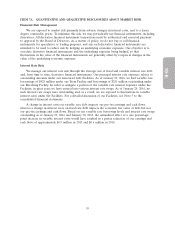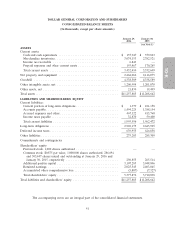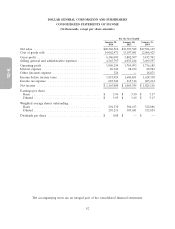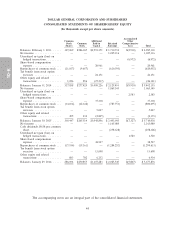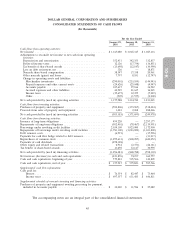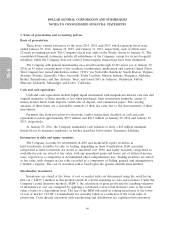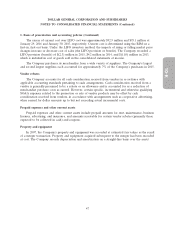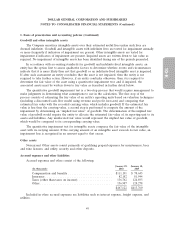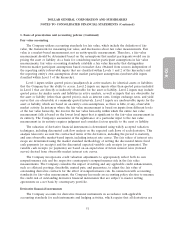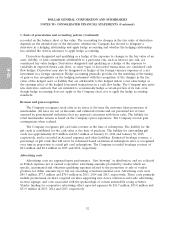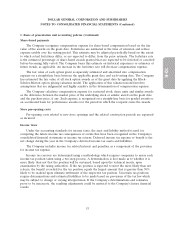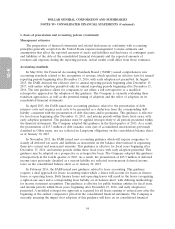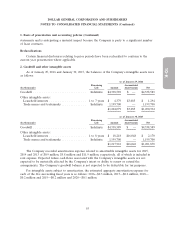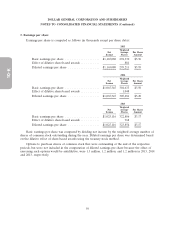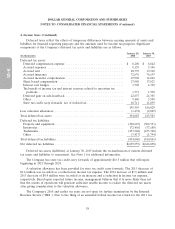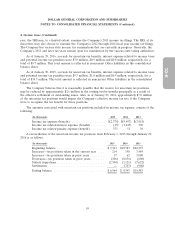Dollar General 2015 Annual Report Download - page 123
Download and view the complete annual report
Please find page 123 of the 2015 Dollar General annual report below. You can navigate through the pages in the report by either clicking on the pages listed below, or by using the keyword search tool below to find specific information within the annual report.
10-K
DOLLAR GENERAL CORPORATION AND SUBSIDIARIES
NOTES TO CONSOLIDATED FINANCIAL STATEMENTS (Continued)
1. Basis of presentation and accounting policies (Continued)
Goodwill and other intangible assets
The Company amortizes intangible assets over their estimated useful lives unless such lives are
deemed indefinite. Goodwill and intangible assets with indefinite lives are tested for impairment annually
or more frequently if indicators of impairment are present. Other intangible assets are tested for
impairment if indicators of impairment are present. Impaired assets are written down to fair value as
required. No impairment of intangible assets has been identified during any of the periods presented.
In accordance with accounting standards for goodwill and indefinite-lived intangible assets, an
entity has the option first to assess qualitative factors to determine whether events and circumstances
indicate that it is more likely than not that goodwill or an indefinite-lived intangible asset is impaired.
If after such assessment an entity concludes that the asset is not impaired, then the entity is not
required to take further action. However, if an entity concludes otherwise, then it is required to
determine the fair value of the asset using a quantitative impairment test, and if impaired, the
associated assets must be written down to fair value as described in further detail below.
The quantitative goodwill impairment test is a two-step process that would require management to
make judgments in determining what assumptions to use in the calculation. The first step of the
process consists of estimating the fair value of an entity’s reporting units based on valuation techniques
(including a discounted cash flow model using revenue and profit forecasts) and comparing that
estimated fair value with the recorded carrying value, which includes goodwill. If the estimated fair
value is less than the carrying value, a second step is performed to compute the amount of the
impairment by determining an ‘‘implied fair value’’ of goodwill. The determination of the implied fair
value of goodwill would require the entity to allocate the estimated fair value of its reporting unit to its
assets and liabilities. Any unallocated fair value would represent the implied fair value of goodwill,
which would be compared to its corresponding carrying value.
The quantitative impairment test for intangible assets compares the fair value of the intangible
asset with its carrying amount. If the carrying amount of an intangible asset exceeds its fair value, an
impairment loss is recognized in an amount equal to that excess.
Other assets
Noncurrent Other assets consist primarily of qualifying prepaid expenses for maintenance, beer
and wine licenses, and utility, security and other deposits.
Accrued expenses and other liabilities
Accrued expenses and other consist of the following:
January 29, January 30,
(In thousands) 2016 2015
Compensation and benefits ......................... $111,191 $ 78,645
Insurance ...................................... 82,182 81,944
Taxes (other than taxes on income) ................... 136,762 124,893
Other ......................................... 136,987 128,278
$467,122 $413,760
Included in other accrued expenses are liabilities such as interest expense, freight expense, and
utilities.
49


